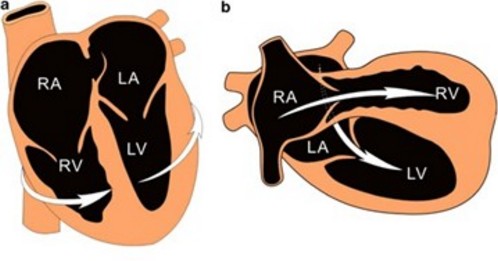Extremely rare. Congenital malposition of the heart due to a 90° clockwise rotation of the whole heart on its long axis without modification of the atrioventricular connections. The right ventricle becomes superior to the left, and the large vessels are displaced backwards and downwards into the mediastinum. This also results in elongation of the brachiocephalic trunks and stretching of the trachea and bronchi, with compression or anatomical anomalies (tracheal bronchus).
This malposition is often associated with an aortopulmonary window and ASD.
The prognosis is poor in cases of associated cardiac or bronchopulmonary anomalies: pulmonary hypertension, frequent infections, respiratory insufficiency.

a: normal b: criss-cross heart
The term “criss cross heart” refers to the clockwise or anti-clockwise rotation of the ventricles in relation to the atria, and abnormal atrioventricular connections RA → LV, LA → RV. Other cardiac malformations are often associated.
Anesthetic implications:
depending on ultrasound data and tracheobronchial anomalies. The carotid and subclavian arteries may apparently arise from the descending aorta and thus have a long mediastinal course. Complex cardiac ultrasound examination.
References :
- Hejazi Y, Mann G, Boudjemline Y, Udassi JP1,Van Leeuwen G1, Diab KA.
Topsy‑Turvy heart with aortopulmonary window and severe airway malacia: prenatal diagnosis and review of the literature.
Pediatric Cardiology 2022 ; 43:225-32
- Altinbas SZ, Dikmen N, Erkent FND, Khalilova P, Ergun E, Can OS.
Anesthetic and surgical management of Topsy-Turvy heart: a case series highlighting cardiopulmonary and airway challenges.
J Cardiothor Vasc Anesth 2025 ; in press
Updated: Mars 2025